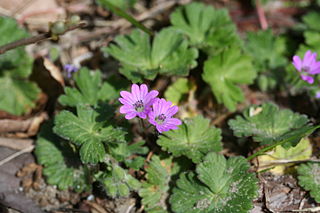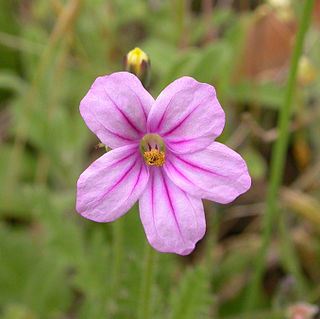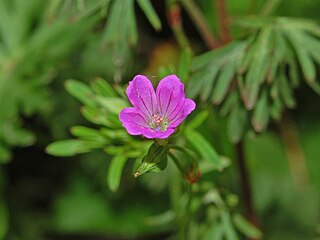
Geranium is a genus of 422 species of annual, biennial, and perennial plants that are commonly known as geraniums or cranesbills. They are found throughout the temperate regions of the world and the mountains of the tropics, with the greatest diversity in the eastern part of the Mediterranean region.

Eryngium maritimum, the sea holly or sea eryngo, or sea eryngium, is a perennial species of flowering plant in the family Apiaceae and native to most European coastlines. It resembles a thistle in appearance because of its burr-shaped inflorescences. Despite its common name, it is not a true holly but an umbellifer.
British NVC community OV5 is an open habitat community in the British National Vegetation Classification system. It is one of six arable weed and track-side communities of light, less-fertile acid soils.

Geranium sanguineum, common names bloody crane's-bill or bloody geranium, is a species of hardy flowering herbaceous perennial plant in the cranesbill family Geraniaceae. It is the county flower of Northumberland.

Erodium is a genus of flowering plants in the botanical family Geraniaceae. The genus includes about 60 species, native to North Africa, Indomalaya, the Middle East, and Australia. They are perennials, annuals, or subshrubs, with five-petalled flowers in shades of white, pink, and purple, that strongly resemble the better-known Geranium (cranesbill). Cultivated plants are known as filarees or heron's bill in North America, whereas in the British Isles they are usually called storksbills.

Erodium cicutarium, also known as common stork's-bill, redstem filaree, redstem stork's bill or pinweed, is a herbaceous annual – or in warm climates, biennial – member of the family Geraniaceae of flowering plants. It is native to Macaronesia, temperate Eurasia and north and northeast Africa, and was introduced to North America in the eighteenth century, where it has since become naturalized, particularly of the deserts and arid grasslands of the southwestern United States.

Geranium molle, the dove's-foot crane's-bill or dovesfoot geranium, is an annual herbaceous plant of the family Geraniaceae.

Montia fontana, blinks is a herbaceous annual to perennial plant that grows in freshwater springs in upland regions, and in seasonally damp acid grassland in the lowlands. It is widespread throughout the world, except in southern Asia. It is rather variable in morphology, which is reflected in a complex history of taxonomy. Currently, there are three accepted subspecies which are defined largely by the appearance of the seedcoat. It is edible and consumed as a salad in some areas, but is otherwise of minimal economic impact. Because of its association with clean water habitats, it is often viewed as a species of conservation value.

Erodium malacoides is a species of flowering plant in the geranium family known by the common names Mediterranean stork's bill, soft stork's-bill and oval heron's bill. This is an annual or biennial herb which is native to much of Eurasia and North Africa but can be found on most continents where it is an introduced species.

Erodium botrys is a species of flowering plant in the geranium family known by the common names longbeak stork's bill, Mediterranean stork's-bill and broadleaf filaree.

Erodium moschatum is a species of flowering plant in the geranium family known by the common names musk stork's-bill and whitestem filaree. This is a weedy annual or biennial herb which is native to much of Eurasia and North Africa but can be found on most continents where it is an introduced species. The young plant starts with a flat rosette of compound leaves, each leaf up to 15 centimeters long with many oval-shaped highly lobed and toothed leaflets along a central vein which is hairy, white, and stemlike. The plant grows to a maximum of about half a meter in height with plentiful fuzzy green foliage. The small flowers have five sepals behind five purple or lavender petals, each petal just over a centimeter long. The filaree fruit has a small, glandular body with a long green style up to 4 centimeters in length.
Erodium brachycarpum is a species of flowering plant in the geranium family known by the common names hairy-pitted stork's-bill and shortfruit stork's bill. It is native to southern Europe but it is known elsewhere as an introduced species and often a weed, such as the west coast of the United States where it is widespread in California and Oregon.

California macrophylla, commonly known as roundleaf stork's bill, is a species of flowering plant in the geranium family, Geraniaceae. It was formerly placed in the genus Erodium, but was later placed in a monotypic genus of its own named California.

Geranium potentilloides, belongs to the family Geraniaceae, and is a small prostrate perennial herb that can grow up to 60cm high. The species is commonly referred to as Soft Cranesbill or Cinquefoil geranium.

Stellaria apetala, lesser chickweed, is an annual herbaceous plant in the flowering plant family Caryophyllaceae. It occurs in short, sandy grassland by the sea and, less often, in similar habitat inland. It is native to Europe and is well established as an introduced species worldwide.

Pelargonium capitatum is one of several species known as rose geranium or rose-scented pelargonium in English. The popular names refer to the scent of the essential oils extracted from glandular tissue, not the flowers, which have hardly any scent to speak of. Some of the species are known as kusmalva in Afrikaans.

Geranium columbinum, common name long-stalked crane's-bill or longstalk cranesbill, is a herbaceous annual plant in the family Geraniaceae.

Geranium nodosum, the knotted crane's-bill, is a perennial herbaceous plant in the family Geraniaceae.

Oenanthe aquatica, fine-leaved water-dropwort, is an aquatic flowering plant in the carrot family. It is widely distributed from the Atlantic coast of Europe to central Asia.

Ranunculus baudotii, brackish water-crowfoot, is a flowering plant in the Ranunculaceae. As the name suggests, it tends to grow near the sea, typically in pools and ditches in coastal marshes that are slightly salty due to sea spray. It can also be found inland where there is some saline influence. It is not edible and has economic uses, but it is generally valued as a plant of conservation interest and an indicator of less agriculturally improved habitat.





















